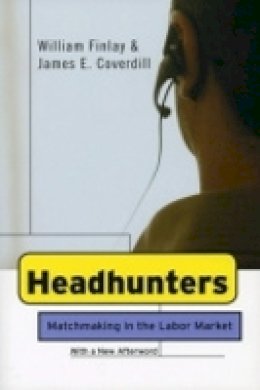
Headhunters: Matchmaking in the Labor Market
William Finlay
Headhunters are third-party agents paid a fee by companies for locating job candidates perform a unique sales role. The product they sell is people, matching candidates with jobs and companies with candidates. Headhunters affect the professional lives of thousands of employees every day, and their work has a profound, though hidden, effect on the employment picture in the United States. William Finlay and James E. Coverdill draw on interviews with and observations of headhunters and on analysis of headhunting training seminars, lectures, industry newsletters, and a mail survey of headhunting firms. The result is a frank and sometimes unsettling portrait of the aims, attitudes, and tactics of practitioners.
The payment of fees has shifted from candidates to employers, and recruiters now find people to fit jobs rather than the other way around. Finlay and Coverdill address what they feel is a serious lack of research about the work headhunters do and how they do it. Their book is built around three major questions: What advantages do employers derive from using third-party agents to handle candidate search and recruitment? How are headhunters able to accomplish the double sale ('selling' candidates to employers and employers to candidates)? What criteria do headhunters use for selecting candidates? In the process, Finlay and Coverdill link their findings to larger issues of institutional and historical context, revealing the economic and political reasons clients use headhunters, demonstrating how headhunters manipulate clients and candidates, and assessing the impact of headhunters' actions on hiring decisions.
Product Details
About William Finlay
Reviews for Headhunters: Matchmaking in the Labor Market
Sharon Collins
The Journal of Industrial Relations
Perhaps the central paradox of the book is that while the headhunter is hired to secure committed employees she works actively and necessarily to lessen such commitments. It is no surprise then that headhunters are commonly reviled while routinely used.... I highly recommend Headhunters to anyone who wants to understand contemporary labor markets.
Ezra Zuckerman, MIT
American Journal of Sociology
This book fills a gap in the literature exploring the growing and unique industry of executive recruiting.... Finlay and Coverdill present a probing view of this often misunderstood industry.... The book covers many aspects of recruiting,including the underlying theory and economics of the industry as well as the nitty-gritty methods and practices used by recruiters.
Harvard Business School
Working Knowledge
The most intriguing portions of the book are those in which the authors use direct quotations to illustrate the deliberate and self-conscious strategies headhunters use to assert control over the job matching process.... The strengths of this book are its rich detail and the authors' insightful interpretations of the complex interactions among and between the actors in the job matching process.... Headhunters is a valuable contribution to our growing understanding of the modern labor market and currently the most compelling and comprehensive study of contingent fee recruiters.
M. Diane Burton, MIT Sloan School of Management
Industrial and Labor Relations Review
They are a tribe with their own language.... They are expert trappers, but also excel at fishing expeditions. And at first encounter in Headhunters: Matchmaking in the Labor Market, they seem friendly enough. But would you like to meet one in a dark boardroom? Yes, if William Finlay and James E. Coverdill are the guides.
Nina C. Ayoub
Chronicle of Higher Education
When did recruiters become known as headhunters' That shift has occurred over the past couple of decades.... Finlay and Coverdill say this approach reflects today's realities.
HR Magazine
